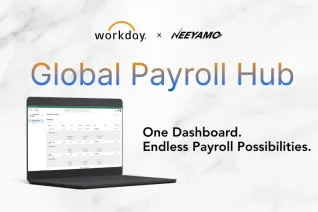How Getting Local Compliance Right Is Non-Negotiable for Global Payroll

With payroll systems under strain from growing compliance demands and workforce expansion, companies are being compelled to rethink their operational approach. The market for payroll solutions is projected to reach USD 17.59 billion by 2032, growing at a steady 6% CAGR. Behind that number is a clear finding: outdated, inflexible payroll models are no longer sustainable in a globalized, fast-moving world.
Payroll has become a frontline expression of how organizations value their people across borders. When compensation feels out of sync with local realities, it erodes trust faster than any policy can repair. To build cohesion in a globally distributed workforce, companies must move beyond transactional payroll delivery and embrace it as a cultural and strategic lever. The question now is: how?
Achieving that alignment requires deliberate action, rooted in both compliance and cultural intelligence.
Strategies for aligning global pay with local values
1. Ensure Compliance with Local Laws and Regulations:
In the context of global payroll, compliance is not merely a legal requirement; it is the foundation of operational integrity and employer credibility.
Managing payroll across multiple countries involves navigating vastly different labor laws, tax codes, and benefit requirements, many of which change frequently and without notice. What’s compliant in one jurisdiction can be a serious violation in another.
As Rajesh, Sr. VP, Payroll Delivery, Neeyamo, explains, “Understanding the nuances of income tax withholding in India versus Brazil or the intricacies of the 13th-month pay in the Philippines requires careful and precise management. This goes beyond compliance. It reflects an organization’s commitment to honoring local obligations and respecting regional employment standards.”
To ensure compliance with local laws and regulations in global payroll, organizations should treat compliance as an ongoing process by continuously monitoring regulatory changes through legal intelligence tools and local industry updates. Engaging local payroll experts or region-specific providers provides vital cultural and legal insights, while investing in automated payroll systems ensures real-time updates and the accurate application of new rules. Finally, standardize global payroll protocols while allowing for local customization to address specific legal or cultural requirements, thereby striking a balance between consistency and local relevance, while ensuring audit readiness.
2. Establish a Centralized Payroll Governance Model:
A centralized payroll governance model provides consistency and control across global operations, while allowing local teams the flexibility to meet country-specific requirements. It helps reduce compliance risks, improves data accuracy, and enhances strategic oversight.
Organizations should define clear, global payroll policies and standards that cover processing, compliance, security, and vendor management, ensuring consistent execution across all locations. Assign regional and local payroll leaders to manage country-specific requirements within this framework, striking a balance between global control and local agility. Centralize payroll data on a unified platform or integrated suite to enable real-time visibility, improve data accuracy, and facilitate enterprise-wide compliance monitoring, ultimately reducing risks and enhancing strategic oversight.
3. Automate and Integrate Payroll Processes:
Manual payroll processes are becoming increasingly risky in a global setting, resulting in errors, delays, and compliance gaps. Automation enhances accuracy, accelerates processing, and provides real-time visibility across regions.
When payroll is integrated with HR and finance systems, it becomes a strategic link, streamlining data, enhancing compliance, and supporting more agile decision-making.
To automate payroll processes, adopt cloud-based, AI-driven platforms that automate everything from calculations and compliance to anomaly detection and global disbursements. Seamlessly integrate these systems with HRIS and ERP tools to ensure accurate, real-time data flow across departments. Automating multi-level approval workflows enhances transparency and minimizes errors, while enabling localization and multi-currency support ensures timely, accurate payments to a global workforce with minimal financial risk.
4. Invest in Employee Communication and Transparency:
Clear and transparent communication about compensation fosters trust, reduces confusion, and strengthens the employee-employer relationship, particularly in diverse cultural contexts. When employees understand how and why they’re being paid, they’re more likely to feel valued, engaged, and aligned with organizational goals.
Effective payroll communication isn’t just about accuracy; it’s about clarity, empathy, and cultural sensitivity.
To enhance payroll transparency and employee trust, start by clearly explaining compensation decisions using simple, multilingual breakdowns supported by visuals or self-service tools. Keep communication channels open, encouraging employees to ask questions while ensuring prompt, culturally sensitive responses through HR or payroll support. Keep employees informed about upcoming changes to pay, benefits, or policies to help them prepare and understand the implications. Where culturally and legally appropriate, promote pay transparency by sharing salary bands, bonus criteria, and career progression guidelines to build credibility and alignment.
5. Customize Compensation Packages to Local Values:
A one-size-fits-all compensation model rarely works in a globally diverse workforce. To ensure fairness, relevance, and employee satisfaction, organizations must align compensation with local cultural expectations, economic conditions, and labor standards.
By customizing pay and benefits to reflect what employees in each region truly value, companies not only foster trust and retention but also strengthen their employer brand at a local level.
To develop a regionally responsive payroll strategy, begin by conducting local market research to understand employee preferences, whether it's higher pay, wellness perks, or flexible schedules, through surveys, benchmarks, or consultations with local HR experts. Tailor benefits like housing stipends, festive bonuses, or transportation aid to match cultural and cost-of-living nuances. Align incentives with societal norms by offering team rewards in collectivist cultures and individual bonuses in more individualistic environments. Finally, ensure that payroll timing aligns with local pay cycles and holidays to maintain trust and operational continuity.
Bridging Strategy and Execution: Where Neeyamo Comes In
Translating these strategies into action requires more than intent; it demands deep local expertise, robust technology, and a globally coordinated approach.
“While evaluating payroll partners at Opella, Neeyamo clearly stood out for their strong technical capabilities and cutting-edge innovations, surpassing the offerings of other providers we considered.”- Anne Bernard, Global Head of People Services.
That’s where Neeyamo plays a critical role and enables organizations to align global pay practices with local realities through:
- Hyper-local compliance expertise across 160+ countries
- A unified, cloud-based payroll platform designed for scale and agility
- Seamless integration with HR and finance systems
- Built-in support for multi-currency payments, localized pay cycles, and regulatory reporting
- Transparent employee experiences through self-service portals in local languages
Whether it's navigating complex compliance landscapes, tailoring compensation to cultural expectations, or ensuring payroll accuracy across borders, Neeyamo empowers businesses to turn payroll from a risk factor into a strategic advantage. Reach out to irene.jones@neeyamo.com to know more!
Latest Resources
Stay informed with latest updates
If you're curious and have a thirst for knowledge pertaining to the HR, payroll, and EOR universe, don't miss out on subscribing to our resources.















